|
Produced by The Center for Baptist
Studies, Mercer University
A Monthly EMagazine, Bridging Baptists
Yesterday and Today
Bruce T. Gourley,
Editor, The
Baptist Studies Bulletin
Wil Platt, Associate Editor, The Baptist Studies
Bulletin
|
| |
|
| |
|
|
In Response to
. . . :
Currently the Interim Director of the Center for Baptist
Studies, Bruce has been on the staff of the Center since 2004. He
previously served as a campus minister and professor of church history. His
most recent book,
Leading the Way For 200 Years: The Story of The First Baptist Church of
Huntsville, Alabama, 1809-2009, was published this month. In addition, he is involved in a number of areas of moderate Baptist life
through the medium of the Internet.
"Baptist
Transitions"
By Bruce T. Gourley

Always
a people in transition, Baptists every so often face particularly notable
demarcations. Major historical Baptist watersheds include the successful
conclusion of over 150 years of advocacy for religious liberty and separation
of church and state in America (as well as the end of Baptist persecution
under colonial theocracies) in the ratification of the Baptist-influenced
First Amendment to the Constitution to the United States in 1791; the parallel
formation of national Baptist denominations and missionary societies in 1792
(the Baptist Missionary Society in England) and 1814 (the "Triennial
Convention" in America); the creation of the Baptist World Alliance in 1905;
and the Baptist-influenced American Civil Rights Act of 1964.
Other transitions,
albeit not as grand in scope, are nonetheless remarkable. The regional split
among Baptists in America evidenced by the Southern Baptist Convention in 1845
and the reconciliation of English General and Particular Baptists in the
Baptist Union of Great Britain in 1891 are two such examples. On another
level, changes routinely take place within specific Baptist groups (such as
the urbanization of Southern Baptists in the late eighteenth and early
nineteenth centuries), while pressure from larger religious trends (such as
the revivalist eras of the early eighteenth and early nineteenth centuries)
reshape Baptists from the outside.
The common thread
in all of these examples is that notable Baptist transitions of the past were
anchored at the grassroots level, a reflection of the importance of individual
believers and local congregations. John Smyth (a clergyman) and Thomas Helwys
(a layman) founded the world's first Baptist church and from that pioneering
congregation first sounded the Baptist cry for religious freedom. A
shoemaker-turned-pastor, William Carey, provided the daring and impetus to form
the first Baptist missionary society, in turn crystallizing Baptists into
national denominational structures. The disaffiliation from the Baptist
Union of Great Britain of Calvinist Charles Spurgeon's Metropolitan
Tabernacle, coupled with the ascendancy of General Baptist pastor John
Clifford, paved the way for Particular and General Baptists to unite in
England. Clifford's influence, in turn, coupled with the vision of John Prestridge, a Baptist newspaper editor in Kentucky, played a key role in the
formation of the Baptist World Alliance. Individual slave-holders, influential
in their respective southern churches, agitated for the formation of the
Southern Baptist Convention. The influence of the great revivals within
Baptist life was most evidenced in the growth of local churches, while the
urbanization of Baptists in the American South, driven by the rise of southern
cities, was visualized in church architecture and worship styles.
Today's Baptists in
America (both traditional and fundamentalist) struggle with their own buffet
of changes, collectively spread across theological and ecclesiological axes and
infused with contemporary politics, culture and generational differences. Are
we experiencing the throes of another major demarcation across the Baptist
landscape, a less remarkable yet important overarching transition, or more
localized group-centric shifts resulting from internal rumblings and/or
outward pressures?
Where will
these changes be evident during Baptists' fifth century? Will the Baptist
future be housed in cavernous buildings designed for entertainment, aging
small town chapels, or neighborhood homes and coffee shops? Has our theology
circled back four centuries to appropriate Calvin's Geneva and the Pope's
authority, waded deeper into the unfolding narratives of contemporary global
perspectives, or become entrenched in the populist grip of a literal Genesis
and figurative Revelation? Will our relationships be lived out in inclusive
communities of equals, dictated by self-assured captains of imperial pulpits,
or isolated in spiritual foxholes governed by gender hierarchy? Will our
historic commitment to religious liberty and separation of church and state
experience renewal in the globally-pluralistic world streaming into our
laptops and iPhones, drown beneath the clashing waves of religious warfare and
theocratic ambitions, or hover uneasily in the safety of political correctness
and the shadow of religious comfort?
Some of
the best of Baptist ideas and work were conceived in the midst of challenges
and birthed via transitions. We may not be able to see clearly yet the changes
now enveloping us, but I am hopeful that great ideas and meaningful work await
the Baptist family in its fifth century.
Table of Contents
|
|
Celebrating 400 Years of Being Baptist:
The Center for Baptist Studies and the Baptist
History and Heritage Society present a twelve-month series of free church
bulletin inserts for use in teaching Baptist heritage in the local church
during the 400 year anniversary of Baptists. The image below is a copy of one
side of this month's pdf document. You can view each month's feature (in pdf format) here.
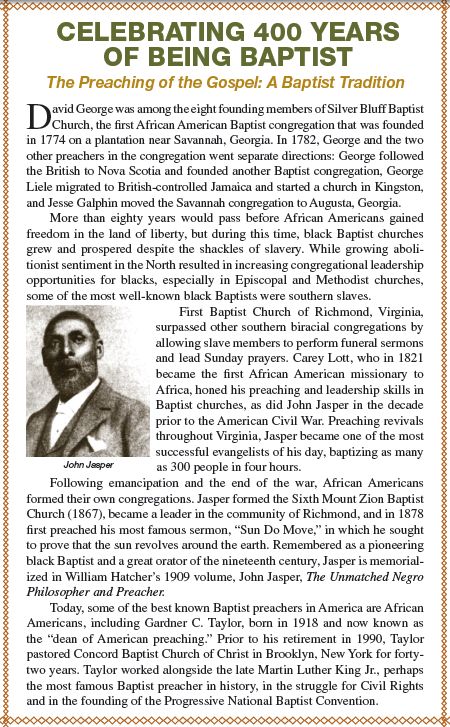 |
Bulletins are
copyrighted
material and
can only be
used for
distribution
within a church.
For permission
to reprint any
text or images,
please contact:
Pamela R. Durso
by email at
pamdurso@
baptisthistory.org
or by phone at (678) 547-6095.
|
Table of Contents
|
|
|
|
The Baptist Soapbox: Invited guests
speak up and out on things Baptist (therefore, the views expressed in this
space are not necessarily those of The Baptist Studies Bulletin, though
sometimes they are).
Climbing upon the Soapbox this month is Pamela Durso,
newly-elected Executive Director of Baptist Women in Ministry.
"Baptist Women in Ministry:
Telling the Story"
By Pamela R. Durso
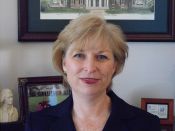
This
past spring, as the Baptist Women in Ministry’s Leadership Team began
to dream together, we talked about the future of the organization.
We spoke out loud all the possibilities, but the dreaming and
talking did not remain simply as words and ideas. They soon took
on life as this amazing group of women chose to move ahead and to
take a step of faith, and now in July 2009, after months of
conversation and prayer, what began as a dream has become a
reality.
Throughout the process, I have been reminded over and over again
that God has been moving ahead of us, preparing the way and that
God has been calling BWIM, its leaders, its supporters to step out
in faith and to move into new territory. And I have had moments
during these past months in which I have seen and heard and felt
the spirit of God working and moving and leading through the
voices and actions and decisions of seven amazing women ministers.
So what
are our dreams? What is the future of BWIM? I am convinced that as
an organization, BWIM needs to be telling stories. As committed
Baptists, as faithful Christians, as ministers of the gospel, as
women and men of faith, we all need to be telling the stories of
our faith.
We need
to tell the story of Jesus gathering the girls and boys and
blessing them . . . and reminding his disciples that “to such as
these belongs the kingdom of God” (Luke 18:15-17). We need to tell
that story to the little girls in our churches and communities . .
. and we need to nurture them in the faith, to love them and
encourage them as they become Christ followers.
We need
to tell the story of Jesus’ resurrection appearance to Mary
Magdalene and his instructions to her to “go and tell.” We need to
tell that story to our middle school girls and high school girls.
We need to sit with them, listen to them, walk with them so that
if they hear that calling to “go and tell,” they will be open to
those words, they will have opportunity to explore that those
words mean. We need to provide them with places and times to talk
about and to express their ministry gifts. We need to encourage
them to preach and teach and sing and pray and lead and serve. We
need to be communities in which girls and young women can hear and
explore God’s call.
We need
to tell the story of Jesus—sitting quietly teaching in the home of
Mary and Martha. We need to tell of his inclusion of Mary in his
circle of students. We need to tell our female seminarians this
story—to assure them that they too are included in the circle and
they need to study and learn. And we must, as churches and as a
BWIM organization, find ways to enhance their educational
experiences and encourage their development of their gifts and
skills. We need to provide words of affirmation, prayers of
encouragement, and financial assistance, and when they are ready,
we need to provide for them places of service. We need to open the
doors of our churches, the doors of our ministries, the doors of
our hearts and welcome them in.
We need
to tell the story of Jesus and the women who walked with him, the
women who were included in his ministry, the women whose names
are listed in Luke’s gospel (Luke 8:2-3) . . . Mary Magdalene,
Joanna, Susanna. We need to tell this story to each other—of
these women who were faithful in following Christ, who
participated in his kingdom work, who supported and contributed to
the spread of the gospel. We need to tell the story of these women
who served together, who became partners in ministry, whose lives
became entwined as they walked dusty roads, talking, listening,
and praying. We need to tell this story to young ministers
beginning their journey who need our affirmation and care, to
ministers who have been walking on the road for a while and need
encouragement and support, and to ministers who have spent their
lives serving and who need to hear our words of gratitude for
their pioneering faith and work.
The year 2009 is a critical moment in time for BWIM as an
organization and for Baptists who believe in and affirm that God’s
calling may be heard and lived out by women and men. We are headed
into new territory, walking a new, unknown path, and as we travel
together we have stories to tell, we have stories to share with
one another, but we are also called to be part of the story of
Jesus. We are called to live out that story.
Excerpted from a Homily presented July 2, 2009 at the Baptist
Women in Ministry Gathering, South Main Baptist Church, Houston,
Texas.
Table of Contents
|
The Baptist Heritage:
Milestones: This
month we focus on an academic journal that has long served the Baptist
community while experiencing significant transition.
Gerald L. Keown, professor of Old Testament and
Associate Dean of the M. Christopher White School of Divinity of Gardner-Webb
University.
"Review and Expositor: 100 Years
and Counting"
By Gerald L. Keown
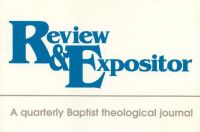
The Review & Expositor, for most of its first one hundred
years of existence, served as the journal of the faculty of The
Southern Baptist Theological Seminary in
Louisville,
Kentucky. As its name suggests, the initial goal was to provide a
resource for ministers which offered an evaluation of books which
could prove helpful in ministry as well as exposition of biblical
texts. Significant portions of early issues were devoted to
reviews. E. Y. Mullins, in the first issue of the journal in April
of 1904, stressed the importance of a forum in which diverse
perspectives could be voiced in areas of theological significance,
diversity which would even include non-Baptist voices. Over time
the nature of the journal underwent change, though reviews of
published materials have consistently been a part of each issue
and the goal of providing informed discussion of important issues
has been retained.
As
denominational controversy began to threaten the atmosphere of
open inquiry that had long characterized the seminary, a key
decision regarding the journal was made by its editorial board,
with the courageous support of seminary president Roy Honeycutt.
The journal became independently incorporated under
Kentucky law. The change did little to alter the nature of the
journal. Content decisions and issue planning had long been the
province of the editorial board without interference from the
seminary administration. The Review & Expositor continued
to function as the journal of the faculty of Southern Seminary,
but the emphasis shifted slightly to give greater importance to
"journal of the faculty."
When control of Southern
Seminary shifted completely to the fundamentalist trustees, the
journal moved off campus and functioned much as it always had,
producing quarterly issues that attempted to address matters of
concern to the church and its ministry. For several decades, the
journal has been thematic in focus. That is, the Editorial Board
introduces key concerns which are perceived to be worthwhile for
consideration as the theme of an upcoming issue of the journal.
Faculty persons qualified to serve as issue editor are identified
who then begin the task of securing writers for the various
articles to be included in the issue.
The dramatic changes in Baptist life as a result of denominational
conflict included the emergence of a number of new seminaries and
divinity schools. The Baptist Theological Seminary at
Richmond was the first, a step of faith initiated by the Alliance
of Baptists and other key supporters of theological education. It
was followed by other "starts," most affiliated with already
established Baptist universities. The resulting institutions were
much smaller than the flagship seminaries of the past, but offered
the opportunity for men and women seeking to prepare for ministry
to do so in an atmosphere which encouraged diverse perspectives
across the theological spectrum.
It soon became clear that
the Review & Expositor could no longer continue without
dramatic changes. What was proposed was dramatic indeed. In 1996,
the journal, over a period of several months and with the careful
oversight of managing editor Dan Stiver and the Editorial Board at
the time, offered invitations to the new seminaries and divinity
schools to enter into a consortium agreement that would then
continue the mission of the journal. The Review & Expositor
went through a transition from the journal of the faculty of The
Southern Baptist Theological Seminary to the journal of the
faculties of the consortium schools.
The consortium consisted of two tiers. Sponsor institutions made a
one-time donation and agreed to provide annual financial support
for the journal's operation. In return, each sponsor institution
was allowed two members to function as part of the Editorial
Board. Patron institutions made no lump sum contributions to the
journal, but provided a similar level of annual financial support
for the operations of the journal. Patron institutions were
allowed one member on the Editorial Board. The Southern Seminary
"tradition" was initially given three positions on the Board,
reduced to two after the first five years of the consortium.
(These were usually retired faculty from Southern Seminary who
were still located in the
Louisville area.) Initial
Sponsor institutions were the Baptist Seminary at
Richmond, Truett Seminary of
Baylor
University, and McAfee School of Theology,
Mercer
University. Patron institutions were Logsdon School of Theology of
Hardin-Simmons University, and the School of Divinity at
Gardner-Webb University. At its founding as a divinity school in
1997, Campbell University School of Divinity became a patron
institution, followed later by Central Baptist Theological
Seminary of Kansas City, KS, and Northern Baptist Theological
Seminary, Lombard, IL.
Truett Seminary ended its
relationship with the journal in 2001. In 2002, Campbell
University School of Divinity moved from a Patron institution to a
Sponsor institution.
The challenges facing all print journals continue to confront the
Review & Expositor. In an increasingly digital and media
age, the Editorial Board has recognized the necessity to adapt.
Several sessions with focus groups from around the country
provided input to the board regarding both positive and negative
aspects of the journal in its current form. A repeated refrain
echoed by a number of the participants in the focus groups
concerned the problems associated with printed matter which
readers considered too esoteric or technical. Ministers in the
conversation pleaded for resources which included pragmatic
elements useful in the hectic world of the modern church. That
included a request for readability and articles that could be read
quickly. In other words, no 35 page articles need apply!
The Editorial Board has attempted to respond to such input in a
number of ways without forfeiting what it believes to be the
long-term strengths of the journal. There have been several
changes reflected in recent issues and they are to be included in
the future. Two brief essays now begin each issue. The first is
entitled A Word From .... The intent of this essay is to
provide a forum in which a notable voice can be heard. Glenn
Hinson, long time professor of Church History at Southern Seminary, and Editorial Board member of the
journal for many years, provided the first series of essays.
Recently, Walter Shurden of
Mercer University offered a series of four essays. Tony Campolo
has also contributed a year's worth of such essays.
The second essay is entitled
A Word About .... and focuses attention on matters of
contemporary significance as identified by faculty members from
the various consortium institutions. The author of this essay
changes issue to issue.
Another change for the journal involves varying options for
receiving its content. Electronic subscriptions are now available
instead of or in addition to print subscriptions. CDROM
collections of the past ten years of the journal are now
available. Soon, the 50 years of Bible study issues will be
collected into a DVD format which will be available for interested
persons. The journal website, www.rande.org, is also
designed to allow communication regarding subscriptions, even
payment for any Review & Expositor item via Paypal.
Issues recently published address such timely themes as
Jewish-Christian Dialogue, Muslim-Christian Relations, an issue on
Bowen Family Systems, and an issue devoted to the Baptist World
Alliance. The Editorial Board of the journal makes a concerted
effort to be true to the storied legacy of this historic journal
while adapting its presentation so as to provide resources that
assist ministry practitioners in the hectic and demanding world of
the 21st century.
For over a hundred years, the Review & Expositor has been
one of the most respected and influential journals in the
United States, with impact around the
world. The title of this essay is “The Review and Expositor: 100
Years and Counting.” If you are a free and faithful Baptist, or
simply a thinking Christian, consider examining the sample issues
available on the website and consider assisting in the
continuation of the valuable heritage that is the Review &
Expositor.
Table of Contents
|
|
|
|
|
30%
Discount on this new title from Baylor University Press
The Acts of the Apostles:
Four Centuries of Baptist Interpretation
Edited by Beth
Allison Barr, Bill J. Leonard, Mikeal C. Parsons, and C. Douglas Weaver
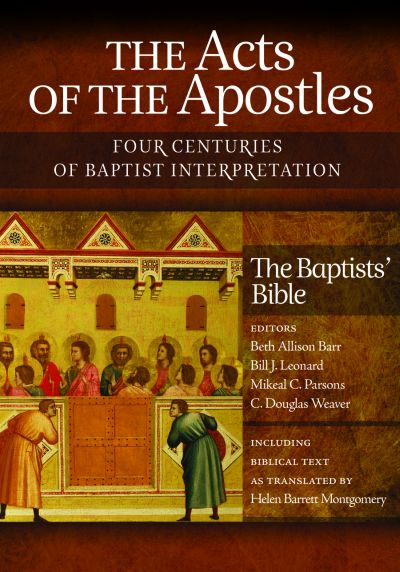
This
groundbreaking work of research contains examples of specific ways that
Baptists have used Acts in their confessions, sermons, tracts, commentaries,
monographs, devotional and denominational literature, hymns, and speeches.
Including the entirety of the Acts as translated by Helen Barrett Montgomery,
this commentary beautifully illustrates the diversity of Baptist responses to
this book of Scripture.
“This is
a path-breaking scholarly undertaking. For Baptists, it is important for
showing the scriptural reasoning that underlies their denominational
existence. For New Testament scholars, it helpfully examines the ways the text
has been interpreted throughout the denomination’s history.” — David W.
Bebbington, University of Stirling
$99.95 $69.95 discount price / 978-1-60258-186-9 / Cloth / 7x10 / 1000
pages / Available July 2009
To receive
the discount price: Contact Hopkins Fulfillment Service at 1-800-537-5487 or
order online at www.baylorpress.com.
Use the discount code "ACT."
|
|
|
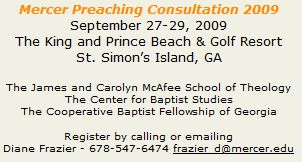
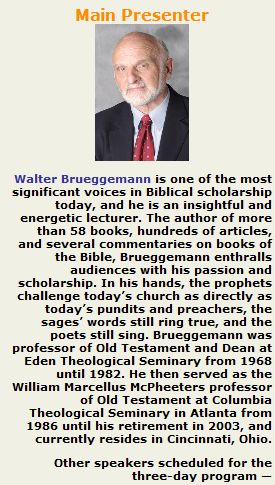
Table of Contents
|
Featured Speakers
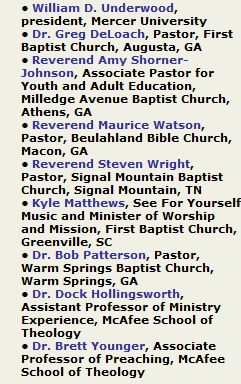
Registration is $100 per person and is on a first-come, first-served
basis.
A golf outing is planned for Monday afternoon.
Questions regarding registration or lodging? Contact Diane Frazier by calling
(678) 547-6470, or by e-mailing
frazier_d@mercer.edu
|
|
| |
|
Recommended Online Reading
Compiled by Bruce Gourley
A Plantation to Be Proud Of
New York Times
"Providence Plantations’ founder, the young Puritan theologian Roger
Williams, arrived in the Massachusetts Bay Colony in 1631. The Boston church
immediately offered him a job as a minister, which he turned down because he
deemed the congregation not quite puritanical enough. In a community of
religious fanatics, the outspoken Williams became the guy who all the other
Puritans wished would lighten up about religion."
Highest Freedom is Freely Giving Self to God, Baptist Historian Says
Baptist Standard
"Baptists must aspire to the kind of freedom that leads them to
relinquish their autonomy to God, historian Walter Shurden told participants
at the William H. Whitsitt Baptist Heritage Society’s annual meeting. Shurden
received the society’s 2009 Courage Award in Houston July 2. He recently
retired as a professor and department chair of Christianity at Mercer
University and as founding executive director of Mercer’s Center for Baptist
Studies."
'Family': Fundamentalism in High Places
National Public Radio
“In the book The Family: The Secret Fundamentalism at the Heart of American
Power, author Jeff Sharlet examines the power wielded by a secretive
Christian group known as the Family, or the Fellowship.”
At 200 Years, Bible Society Reenacts Start
Boston Globe
“What we’ve been trying to do is figure out where we go for the future, and
figure out the electronic means of spreading the Bible,’’ he said. “Two
hundred years ago, the purpose was to give out Bibles, but today people have
Bibles, so that’s not a big deal. The question is, how do we make it usable?” |
|
| |
|
| |
|
Dates to Note: Baptist Events Calendar
July 20-25, 2009, Baptist Peace Fellowship of
North America annual conference, Weber State University, Ogden, Utah.
More information.
August 6-7, 2009, New Baptist Covenant Midwest
Meeting in Norman, Oklahoma. Guest speakers include former U.S. president
Jimmy Carter.
More
information.
September 24-25, 2009, Baylor Conference on
History, Philosophy, or Practice of Baptist Church Music. Email Dr.
David W. Music at
David_Music@baylor.edu for more information.
September 25-27, 2009,
Amherst, Nova
Scotia, Canada, a weekend celebration of the 400th Anniversary of the Baptist
Movement and the 200th Anniversary of First Baptist Church, Amherst,
sponsored by the Atlantic
Baptist Fellowship and First
Baptist Church,
Amherst, NS. Featured speakers include Drs. Peter Paris, William Brackney
and Roger H. Prentice.
Click here for more information.
September 27-29, 2009, Mercer Preaching
Consultation, King & Prince Beach & Golf Resort, St. Simons Island, Georgia. Featured
speaker: Dr. Walter Brueggemann. To register or for more information, contact
Terri Massey by email or phone her
at 478.301.2943.
October 1-3, Pruit Memorial Symposium, Baylor
University. Topic: "Religion, Politics and Society: The Baptist Contribution."
Featured speakers: Nancy Ammerman, Randall Balmer, Fisher Humphreys.
July 28-August 1, 2010, 20th Baptist World
Congress of the Baptist World Alliance, Honolulu, Hawaii. Registration
is now open. More
information.
If you know of a Baptist event that needs to be added to
this list, please
let us know.
Table Of Contents
|
|
| |
If
you do not wish to receive the BSB any longer, please
click here to unsubscribe. |